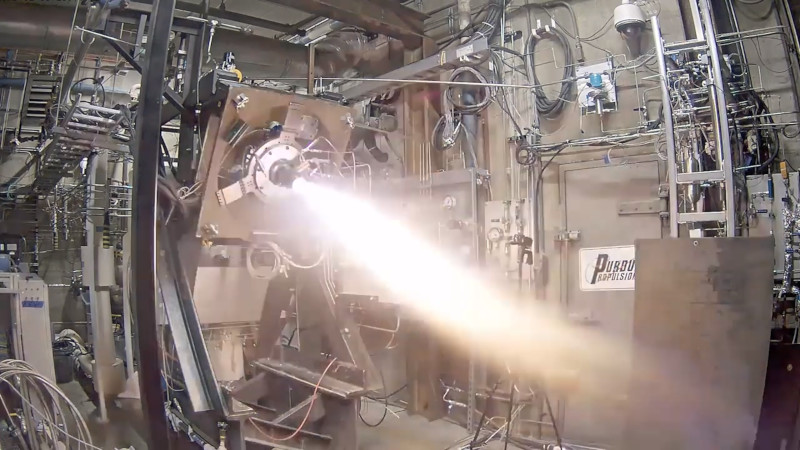Solid rockets are a fun way to get started in rocketry. Brewing up a batch of rocket candy is something achievable even in the home lab, and anyone can give it a go with the right materials. Building a flight-capable liquid-fuelled rocket engine is another thing entirely, but the Purdue Space Program is up to the task.
The result of their hard work is Boomie Zoomie, a rocket which stands 15ft tall and weighs 130lbs. With peak thrust of 800 lbs, it’s got plenty of grunt to help get things off the ground. It’s fuelled by liquid methane, a first for a university-built rocket. The craft is constructed out of 6″ aluminium pipe sections, which were a best-case trade-off between weight, cost, and machinability. Special care was taken during the design process to make things modular, to both allow for future design revisions and ease of field prep. This allows different parts of the team to work independently, streamlining the process of preparing the rocket for launch.
Aiming to compete in the FAR MARS liquid rocket competition, the rocket has undergone two successful hotfires. The team estimates that the first launch should happen in the next few months. Preparations are continuing on the launch trailer and ancilliary support equipment to get things up and running. The aim is to reach a lofty altitude of 45,000 feet.
For those interested in a career in rocketry, Purdue may just be the place to be, with over 300 members in its space program. We’ve seen other top-notch collegiate rocket programs, too – such as this Boston University effort that aims to reach space. Video after the break.
[Thanks to Declan for the tip!]
















Coaxial fuel tanks! Cool!
Brewing up a batch of rocket candy is something achievable even in the home lab, and anyone can give it a go with the right materials.
Maybe it’s best to take a cue from JPL if you don’t want to burn your house down.
I blew the door off my microwave making rocket candy.
um…
It was an experiment, okay? Now we know.
csw
Nice to see something from across the river on HaD. I saw the rig at the celebration and lecture for the 50th anniversary of Neil Armstrong taking a stroll on the Moon. Go Boilers!
45000 feet means little.
How about some metric please, especially since pretty much the entire world uses it (with one outstanding exception)?
Hear Hear !
That is 22500 people. Quite a lot of people.
Or 7500 ants (Not so many ants)
But it’s 45000 pirates, armed with rockets. Could be quite a problem.
I’m all for metric but feet have become an international convention for altitude measurement and reporting in airspace. I understand that to try and switch to metric now would have an unacceptable risk of aircraft crashes. So as the rocket would be largely travelling in what would be considered airspace altitudes, feet are probably the most appropriate unit, in my opinion.
But we are talking about rockets here, and that means space. Yes, we do pass a short amount of time trough airspace. But the real space “boundary” is 100km. So this ~14km is a long way from it. (See what I did there)
But the height isn’t the achievement here. It’s the experimental fuel.
“ a rocket which stands 15ft tall and weighs 130lbs. With peak thrust of 800 lbs “
Yep, there we go again, google their secret language to be able to read the article.
“ a rocket which stands 4.6 meter tall and weighs 59 kg. With peak thrust of 3.6 kilo newton“
(assuming the last lbs is a typo and should be lbf)
Comparing that to a sounding rocket “RH 125”
https://en.wikipedia.org/wiki/Rohini_(rocket_family)
It’s specs are not great compared to that. But also not horrible.
Thnx, helpful.
Divide by 3, divide by 2, divide by 200.
Having a sense of proportion for units is important. Well at least for americans and people that deal with americans.
Not to be that crazy American, but even though we still use Imperial units at least we can do conceptual math in our heads without complaining…
45000 ft approximately equals 13 km
Why expect the author to do the conversion for you? Converting from feet to meters is only a few keystrokes away? I’ve had to convert from (kilo-)meters to feet or miles when reading articles measuring in metric. I have an app on my smart phone that does it for you. Easy! And then YOU can post a positive comment instead of a negative one. World peace is the goal here, eh? Get on board, we need your help too! :)
Peace and blessings.
Rememberto check local law. Brewing SRP is illegal in many countries including here in the UK.
In the UK almost everything is illegal.
Especially concrete dogs. Do you have a license sir?
https://youtu.be/FN4wGfFuyjc
Does that include dentistry? ;-)
Looks like they’re firing that thing indoors! Safety win – wouldn’t want to singe any wildlife :O)
Purdue, eh?
Was George Gobel involved?
He might have a steak in hand to grill at launch, eh.
There is a girl in the team.
All is good.
Yes, they let girls go to school now..
Who knew?